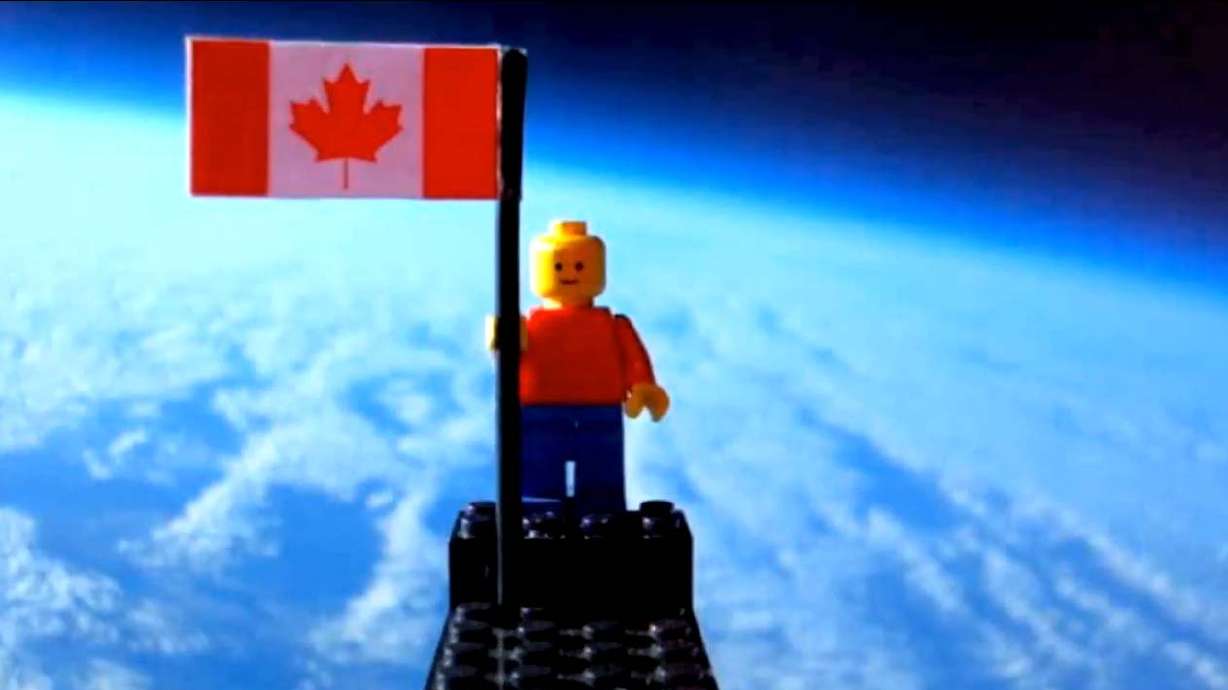Estimated read time: 4-5 minutes
This archived news story is available only for your personal, non-commercial use. Information in the story may be outdated or superseded by additional information. Reading or replaying the story in its archived form does not constitute a republication of the story.
TORONTO — Two Canadian teens have successfully sent a (LEGO) man into space — technically, into the stratosphere — using a homemade parachute and equipment found on Craigslist.
Mathew Ho and Asad Muhammad, both 17, attached the LEGO figurine to a helium-filled weather balloon and launched it, along with four cameras, 80,000 feet into the air — three times higher than the typical altitude of a commercial plane.
Ho said he was inspired by a video he saw two years ago of students at the Massachusetts Institute of Technology launching weather balloons.
"The blueness of the earth contrasted against the blackness of space was pretty incredible," he said. "I just really wanted to do it and I knew I could do this."
Ho and Muhammad spent four months' worth of Saturdays and only $400 on the project.
They assembled a light-weight Styrofoam box to protect the wide-angle video camera and the three Canon point-and- shoot cameras they had found on Craigslist. The Canons could be programmed to snap pictures every 20 seconds without stopping.
It took three weeks to sew the rip-stop nylon parachute, which the two tested by throwing it off the roof of Ho's father's 40-story condominium.
Finally, the two bought an $85 professional weather balloon online, and $160 worth of helium at a party supply store.
The four cameras, handwarmers and a cellphone with a GPS application found a home in the Styrofoam box, the parachute and weather balloon were attached, and the LEGO figurine was super-glued to a gangplank outside of the box.
Just pursue your ideas; you never know what's possible with hard work and determination.
–Mathew Ho
The teens used a website that projects trajectories to predict their astronaut's landing place: Peterborough, about 75 miles away.
They had a small amount of control over how far away the LEGO man would land: the more helium they put in the balloon, the higher the speed and the faster it would pop, given it less opportunity to drift in the day's high winds.
Helium-filled balloons pop at what is called "burst altitude" — the altitude at which the gas inside the balloon stretches the latex to its limit, causing it to pop.
"You've got a balloon and you've got a fixed amount of helium in it," Barth Netterfield, a professor of physics at the University of Toronto, told the Toronto Star. "So as the balloon goes up, the pressure outside is going down so the balloon is going to stretch. The higher you go, the more the balloon expands until, eventually, the rubber isn't strong enough and it bursts."
Ideally, the balloon would land as close as possible to the launch site, and not in water or in the United States. Thus, Ho and Muhammad emptied a 931-cubic-foot tank of helium into the balloon, hoping they would be able to retrieve it.
The round trip took less than two hours, hardly long enough to take the balloon too far off course. It took two weekends of searching, though, to find the project, because of a lack of cell phone service where it had landed. Eventually, the LEGO man was found, along with the cameras holding about 1,500 stunning photos.
I guess the sky is not really the limit, anymore. We never knew we'd get this far. It's been a lesson for us that hard work pays off.
–Mathew Ho
The photos were the reward for an experience that was frustrating at times, according to Ho, who said there were a lot of obstacles to overcome.
The two hope to pursue similar projects in the future, time permitting, perhaps by launching a balloon higher into the atmosphere and using better cameras. For now, they are focusing on graduating from high school and applying to college: the University of British Columbia or Queen's University for Ho, and the University of Toronto or Centennial College for Muhammad.
"I guess the sky is not really the limit, anymore," Ho said. "We never knew we'd get this far. It's been a lesson for us that hard work pays off."
"Just pursue your ideas; you never know what's possible with hard work and determination."
The two have found themselves in the spotlight as the video of LEGO Man in Space, as they call the project, has gone viral.
"It's been amazing since we launched it," Ho said. "It's a really great feeling knowing that we're sharing our photos and video with the world. Knowing that we can evoke inspiration, creativity and provoke joy through a four- centimeter-tall LEGO man, that's pretty incredible."









